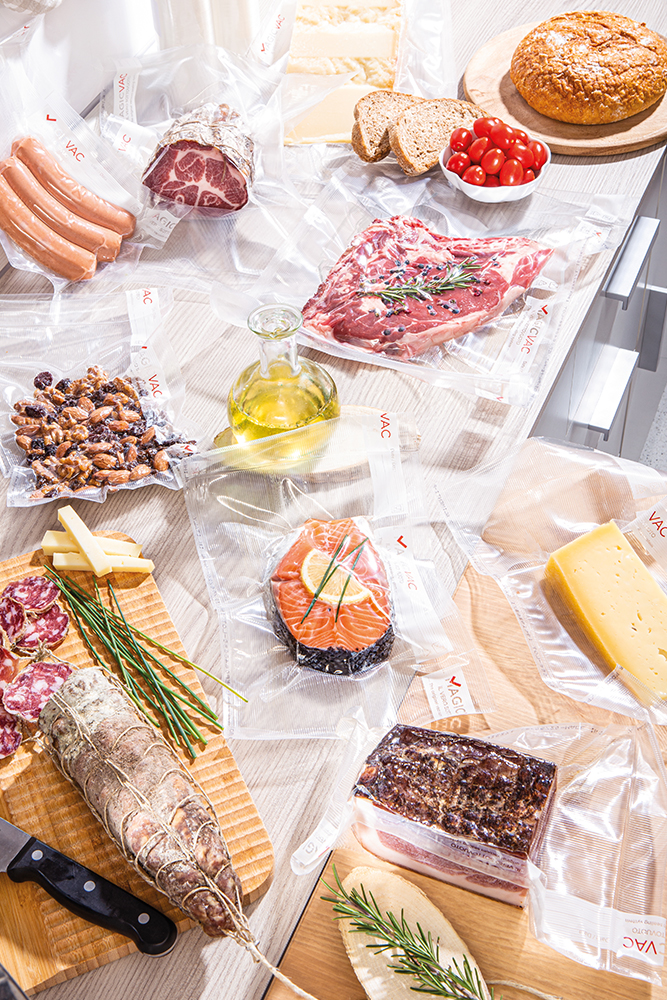How to store with the original patented MAGIC VAC® bags
Vacuum packing for the freezer.
First, use food that is as fresh as possible. The MAGIC VAC® system will allow you to keep all the freshness of your food only if it has been stored correctly. Some foods have a soft texture that could be damaged by vacuum packing, carried out on fresh products. For delicate products such as meat, fish, berries, bread etc., pre-freezing is recommended. In the first twenty-four hours, there is no risk of freezer burns and, therefore, you can vacuum pack pre-frozen foods in MAGIC VAC® bags the day before and then store them in the freezer for long periods, to best preserve all the sensory and nutritional features of the product that you have packed. When it comes to vacuum storing soups, stews or other liquid food, pre-freeze them in a baking dish or a temperate plate. When they solidify, package them in the vacuum, label them and replace them in your freezer. To vacuum store vegetables, clean and peel them, the blanch them, passing them quickly in boiling water or in the microwave until they are heated, while remaining crisp. Then vacuum pack them in convenient portions.
If the food is not pre-frozen, leave an extra length of 5 cm in the bag to allow for expansion due to freezing. For meat and fish, it is advisable to place food on a paper towel and vacuum pack it with a paper towel in the bag. This will help absorb moisture from the food.
To store food like focaccia bread, crêpes and small hamburger buns, overlap them, inserting waxed paper or plastic wrap between one piece and another. This will allow you to remove part of the food, repackage the rest and put it immediately back into the freezer.
Vacuum packing for the refrigerator
For busy families, food can be prepared in advance, put under vacuum and stored in the refrigerator and used in stages, ready to heat when is necessary.
Vacuum packing for the pantry
Even food that can be stored at room temperature (for example coffee, flour, pasta, sugar, etc.) can take advantage of vacuum packing. If these products must be unused for several days, as happens when you are away from home or leave for a holiday, it is advisable to protect your food with vacuum packing. They will be kept fresher and room moisture, mould and insects will not be able to damage them.
Thawing Magic Vac® bags
To defrost vacuum packed food, put them on the lowest shelf of the refrigerator to thaw them slowly, if dealing with meat, fish, fruit, vegetables or other delicate foods. If dealing with bread or focaccia, leave them at room temperature. If, instead, you are dealing with soup or other liquids, soak the bags with their contents in hot water until they reach the right temperature.
When you leave them at room temperature or heat them in Bain Marie, make sure to cut open a corner of the bag to let the steam come out. After the food is defrosted, consume it immediately. Do not re-freeze.
Vacuum re-packing of pre-packaged food
Many foods are sold pre-packaged in industrial vacuum bags, such as cheese and meat. To maintain the taste and freshness of these foods, re-package them in MAGIC VAC® bags once the industrial bag has been opened. Pre-packaged foods must however be consumed by the expiry date indicated on the original product package and treated with the utmost care and hygiene during vacuum re-packing operations.
Helpful hints:
• For foods with sharp points or edges, like bones or spaghetti, pad the edges with paper towels to avoid puncturing the bag.
• Many non-food products can also be vacuum stored. You can store camping equipment such as matches, first aid kits and clean, dry clothes. You can vacuum store your warning triangle in the car for emergencies.
You can maintain the freshness of pipe tobacco, silverware, and collector pieces.

